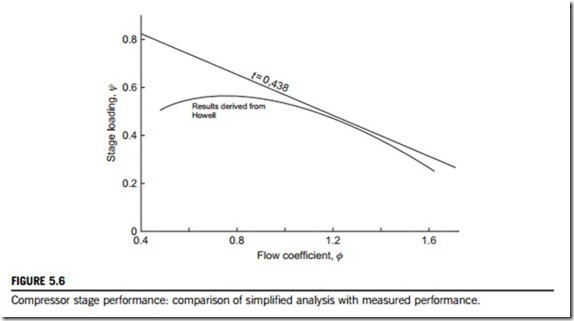Off-design performance
As mentioned previously, it is critical for a compressor stage to have adequate stable operating range. A characteristic map for a single-stage high-speed compressor is shown in Figure 2.4. The design operating point will typically be at 100% speed, at the condition where the design pressure ratio is achieved with sufficient margin to the instability (or surge) line. As the compressor moves off-design at fixed rotational speed, the nondimensional mass flow is either increased or decreased from the design value. If the mass flow is reduced, the incidence onto the blades increases and the stage moves toward instability. At increased mass flow the incidence decreases becoming negative, and the blade passages may become choked. The effects of incidence on compressor blade aerodynamics are covered in Section 3.5.
For a low-speed compressor, the operation is independent of rotational speed, and there is no risk of the flow choking. As shown in Chapter 2, the performance characteristic can be presented as a single curve relating stage loading ψ to flow coefficient φ. Horlock (1958) considered how the off-design performance of a low-speed repeating compressor stage is influenced by the choice of design parameters. He made a simplification, based on cascade data, that that the fluid outlet angles β2 for the rotor and α1(5α3) for the stator do not change appreciably over a range of incidence. This assumption is expected to be valid, since the flow should broadly be aligned with the exit metal angles of the blade rows, but it neglects any variations in flow deviation.
The simplification can be written, for a given compressor stage, as
Hence, the values of ψd and φd chosen for a particular stage design determines the value of t. It is instructive to learn how off-design test results obtained from a compressor stage compare with this simplified performance model. Test results for a low-speed compressor stage were obtained by Howell (1945) in the early days of axial-flow compressor design but they are still valid for our pur- pose. Figure 5.6 shows the variation of the stage loading coefficient ψ plotted against the flow coef- ficient φ. The design point for this stage is actually at about φ 5 0.80, which corresponds to the maximum efficiency condition. At this flow coefficient, the relative flow angles are β1 5 45.8o and β2 5 12.2o. From these data we can derive a value for t 5 tan α1 1 tan β2. Now,
Substituting for t in Eq. (5.25b), the theoretical relationship is found:
which is plotted in Figure 5.6. The comparison of the measured results with the theoretical result clearly demonstrates that there is a fault in the assertion that the flow outlet angle from a blade row does not change.
Figure 5.7 shows velocity triangles for a compressor stage operating at the design point and at a reduced, off-design flow coefficient. In this, the effects of deviation have been included, and it can be seen that the rotor deviation reduces the tangential flow velocity at rotor exit, cθ2, and the (upstream) stator deviation increases the rotor inlet tangential flow velocity, cθ1. Hence, the stage loading, from Eq. (5.17a), ψ 5 ðcθ2 2 cθ1Þ=U, is expected to be significantly reduced by the effects of deviation, as is evident in Figure 5.6. The impact on performance is more pronounced at very low flow coefficients, where the high incidence can also lead to flow separations and increased 3D effects.


